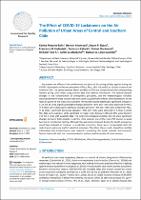Mostrar el registro sencillo del ítem
The Effect of COVID-19 Lockdowns on the Air Pollution of Urban Areas of Central and Southern Chile
| dc.contributor.author | Morales-Solís, Karina | |
| dc.contributor.author | Ahumada, Hernán | |
| dc.contributor.author | Rojas Quincho, Jhojan Pool | |
| dc.contributor.author | Urdanivia Lermo, Francesco Renato | |
| dc.contributor.author | Catalán, Francisco | |
| dc.contributor.author | Claramunt, Tomas | |
| dc.contributor.author | Toro A., Richard | |
| dc.contributor.author | Manzano, Carlos A. | |
| dc.contributor.author | Leiva-Guzmán, Manuel A. | |
| dc.date.accessioned | 2022-05-03T21:10:00Z | |
| dc.date.available | 2022-05-03T21:10:00Z | |
| dc.date.issued | 2021 | |
| dc.identifier.citation | Morales-Solís, K., Ahumada, H., Rojas, J.P., Urdanivia, F.R., Catalán, F., Claramunt, T., Toro, R.A., Manzano, C.A., Leiva-Guzmán, M.A. (2021). The Effect of COVID-19 Lockdowns on the Air Pollution of Urban Areas of Central and Southern Chile. Aerosol Air Qual. Res. 21, 200677. https://doi.org/10.4209/aaqr.200677 | es_PE |
| dc.identifier.uri | https://hdl.handle.net/20.500.12542/2024 | |
| dc.description.abstract | We present the effects of the confinement and physical distancing policies applied during the COVID-19 pandemic on the concentrations of PM10, PM2.5, NO, NO2 and O3 in 16 cities in central and southern Chile. The period between March and May in 2020 was compared with the corresponding months during 2017–2019, using surface data and satellite information. The relative percent changes in the concentration of atmospheric pollutants, and the meteorological variables observed between these two periods were used to quantify the effects of the lockdowns on the local air quality of the urban areas studied. The results showed statistically significant changes in 11 of the 16 cities. Significant relative changes between +14% and –33% were observed for PM10 in 9 cities; while statistically significant changes between –6% and –48% were evident for PM2.5 in 10 cities. Significant decreases between –27% and –55%, were observed in 4 cities in which NO2 data were available; while significant increases in O3, between 18% and 43%, were found in 4 of the 5 cities with available data. The local meteorological variables did not show significant changes between both periods. In all the cities studied, one of the main PM sources is wood burning for residential heating. Although the quarantine imposed during the health emergency could have induced an increase in residential emissions, these were compensated with the reductions in vehicular and/or industrial emissions. Therefore, these results should be carefully interpreted and should inspire new research considering the social, cultural, and economic factors that could alter the common emission patterns and air quality of urban centers. | es_PE |
| dc.format | application/pdf | es_PE |
| dc.language.iso | eng | es_PE |
| dc.publisher | AAGR Aerosol and Air Quality Research | es_PE |
| dc.relation.uri | https://aaqr.org/articles/aaqr-20-12-covid-0677 | es_PE |
| dc.rights | info:eu-repo/semantics/openAccess | es_PE |
| dc.rights | Atribución-NoComercial-SinDerivadas 3.0 Estados Unidos de América | * |
| dc.rights.uri | http://creativecommons.org/licenses/by-nc-nd/3.0/us/ | * |
| dc.source | Repositorio Institucional - SENAMHI | es_PE |
| dc.source | Servicio Nacional de Meteorología e Hidrología del Perú | es_PE |
| dc.subject | COVID-19 | es_PE |
| dc.subject | Urban Air Quality | es_PE |
| dc.subject | Particulate Matter | es_PE |
| dc.subject | Air Pollution | es_PE |
| dc.title | The Effect of COVID-19 Lockdowns on the Air Pollution of Urban Areas of Central and Southern Chile | es_PE |
| dc.type | info:eu-repo/semantics/article | es_PE |
| dc.identifier.doi | https://doi.org/10.4209/aaqr.200677 | |
| dc.identifier.journal | Aerosol and Air Quality Research | |
| dc.subject.ocde | https://purl.org/pe-repo/ocde/ford#1.05.08 | es_PE |
| dc.subject.sinia | contaminacion del aire - Aire y Atmósfera | |
| dc.type.sinia | text/publicacion cientifica | |
| dc.identifier.url | https://hdl.handle.net/20.500.12542/2024 |
Ficheros en el ítem
Este ítem aparece en la(s) siguiente(s) colección(es)
-
Artículo científico [171]









